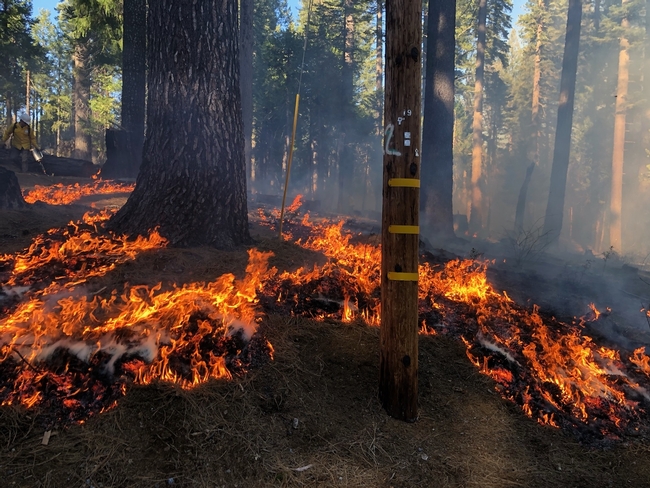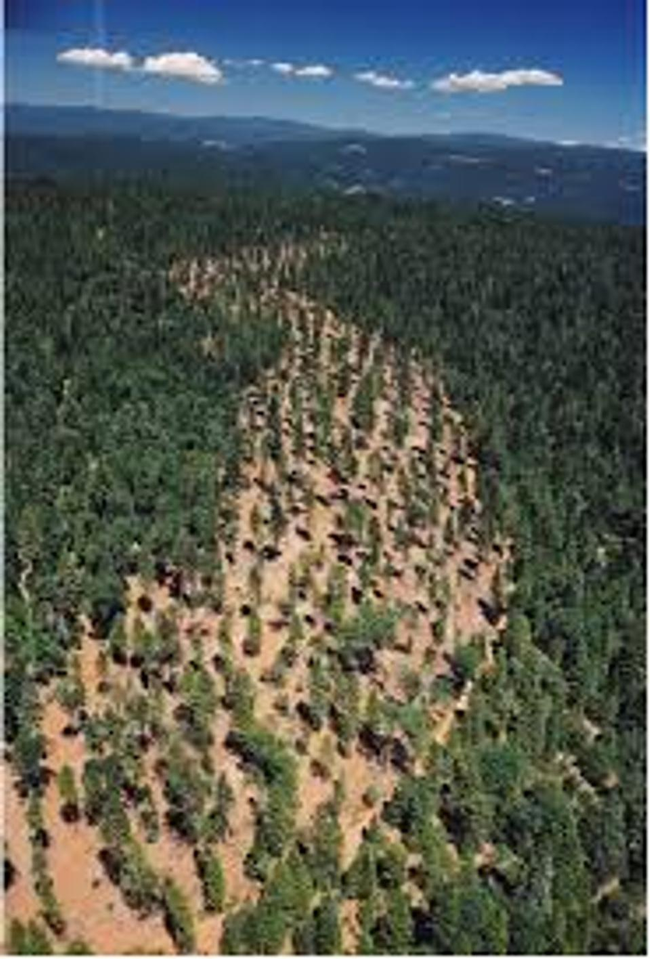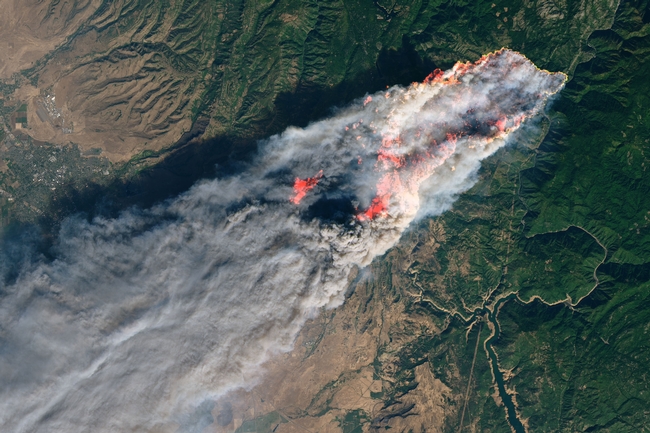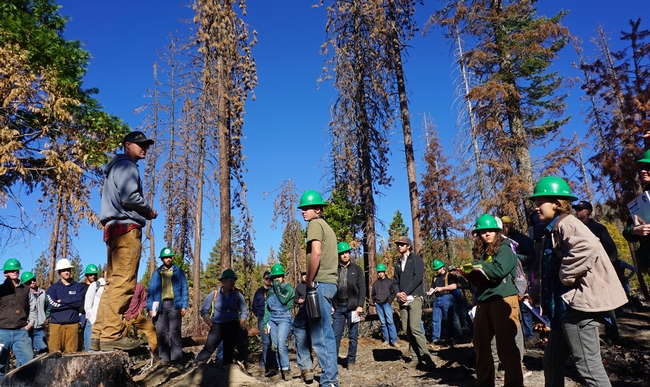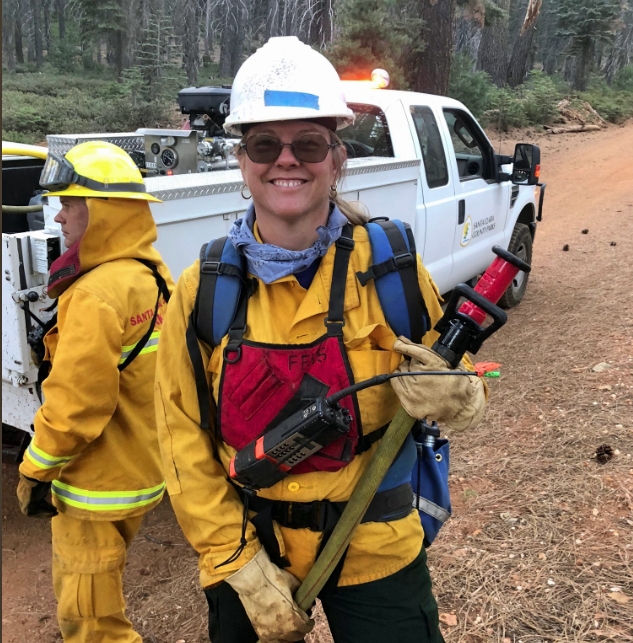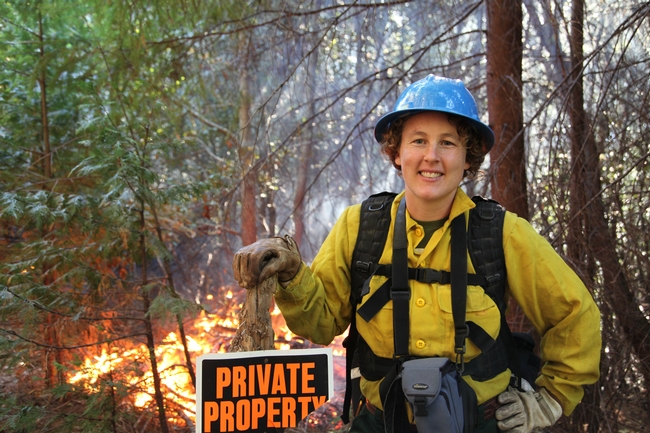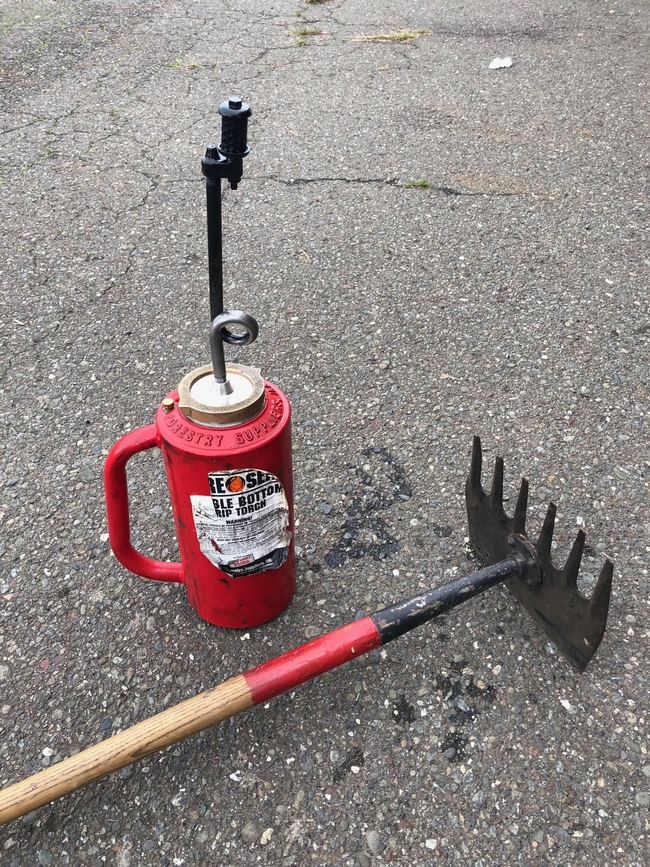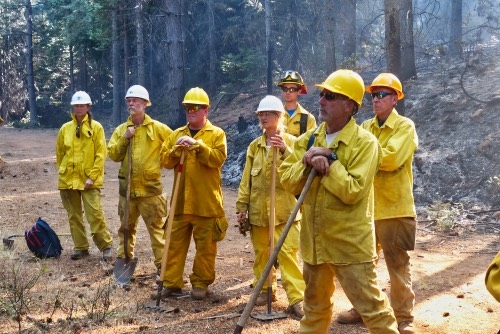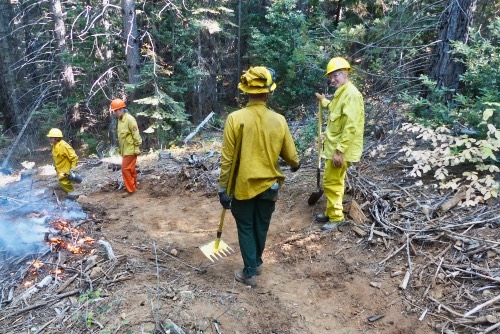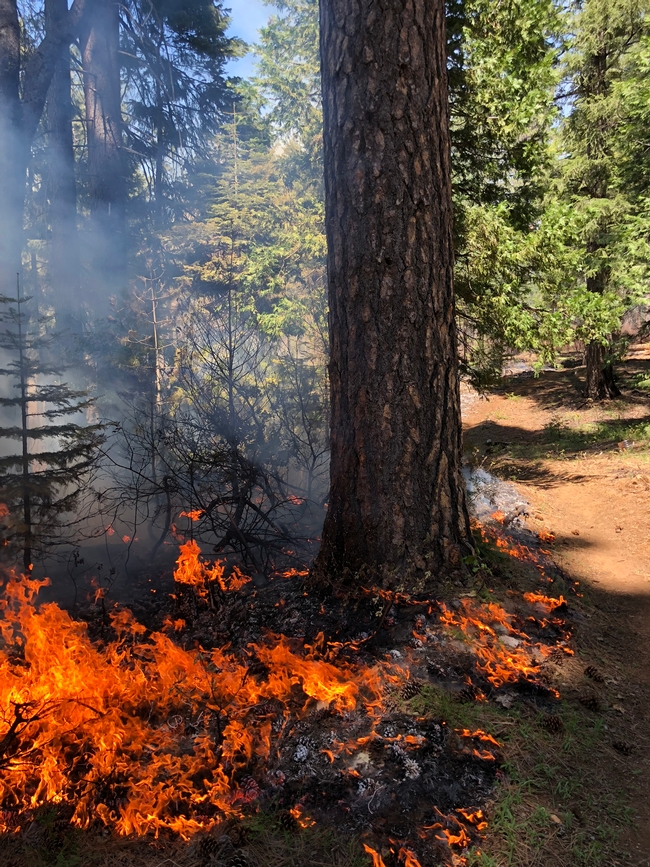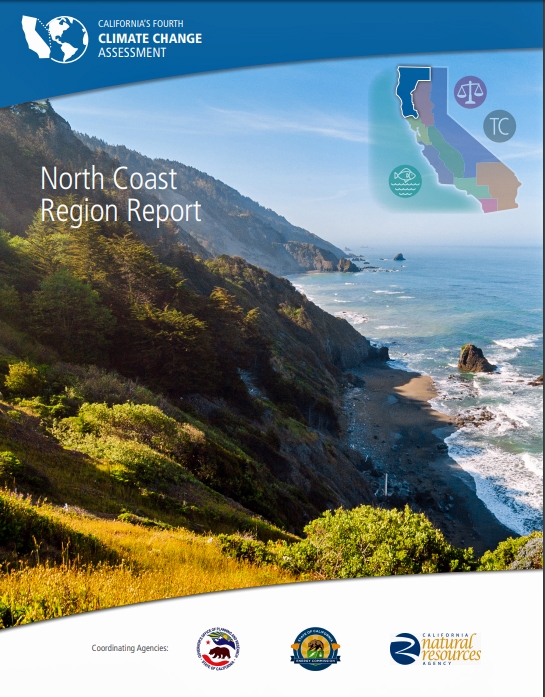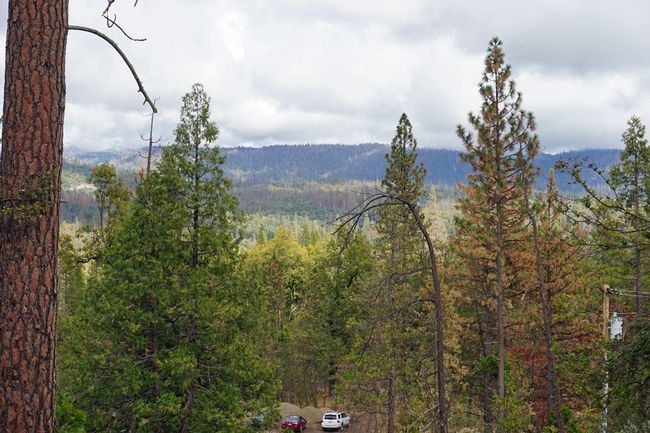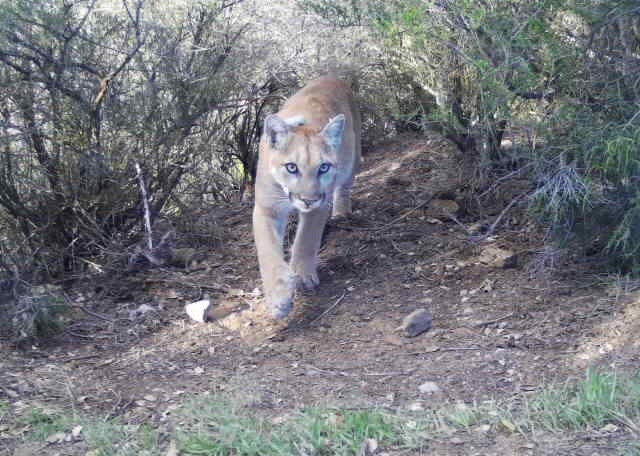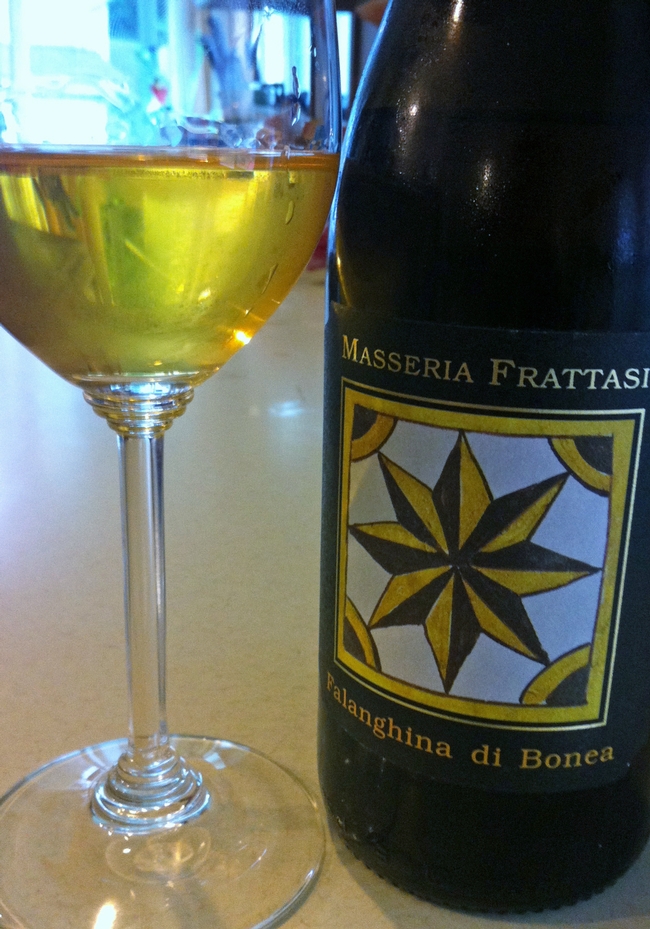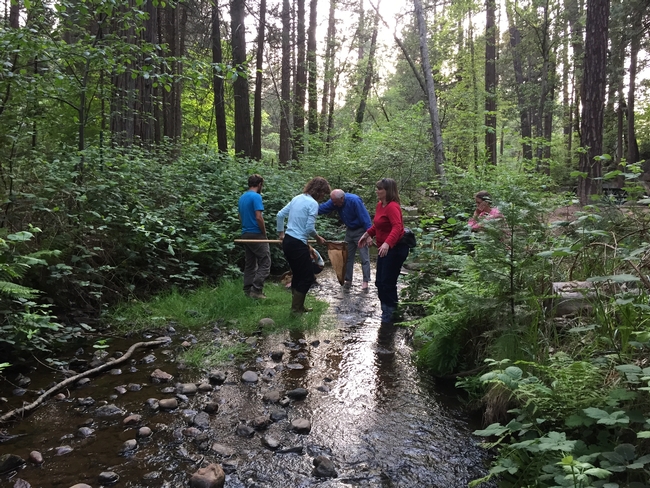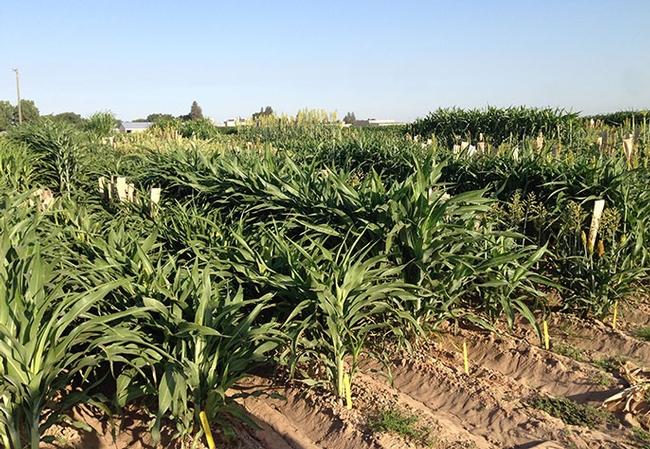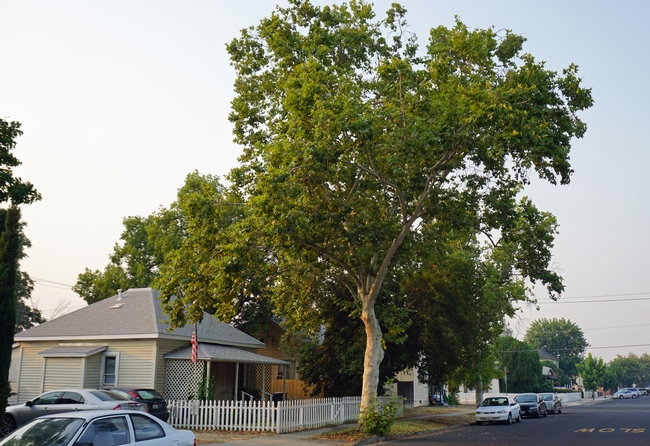Posts Tagged: Rob York
To reduce wildfire risk, forestland owners can do winter controlled burns, says UCCE expert
When conditions are right, winter can be a good time to conduct prescribed burns for forest management, says Rob York, UC Cooperative Extension forestry specialist.
“A huge issue we have in California is fire severity. We know from research that prescribed fire can be a very good tool for reducing fire severity,” York said. “For forest landowners or foresters who want to do their own prescribed burning, winter burning can be a good entry point.”
York is based at the UC Blodgett Forest Research Station in Georgetown, where he developed a series of eight short videos demonstrating how fire can be used on landscapes during the colder months. The videos feature controlled fires conducted at the station on Dec. 6 and 9, 2020. More videos in this series will be posted during the upcoming year.
Among the factors covered in the videos are climatic conditions and site selection for winter burning.
Climatic conditions
Wet or snowy weather in the fall may seem to shut the window for prescribed burning, but York said often the snow melts away and fuels dry out enough to do a winter burn.
“The idea is to be ready when the fuels dry out,” he said. Thinning trees and masticating underbrush are ways to prepare the forest for a burn.
When selecting the day of the fire, relative humidity, temperature and wind speed and direction are important considerations.
“Relative humidity should be low. You want the cloud cover to be very low. A sunny day helps dry out the fuel,” York said. “In the winter, you want that drying and heating power of the sun to help the fuel be consumed.”
Site selection
Among the factors to consider in selecting locations for winter burns is the aspect. The sun's warmth is optimized on south-facing slopes.
“That's what we're looking for,” York said. “Relatively small areas that are burnable.”
An open canopy allows sunlight to dry out the understory vegetation and surface fuels, enabling successful winter burns.
Vegetation type also weighs into winter burning decisions.
“Bear clover plus pine needles make this feasible, including conditions on the wetter side when you might not otherwise be able to burn, you can burn,” York said. “If you can encourage bear clover and pine needles, you can encourage more opportunities for low density burns, which I think do a great job to maintain low fire hazard.”
Find the complete series on the UC Forestry and Range YouTube channel (https://www.youtube.com/user/UCExtensionForestry) in the playlist titled Winter Prescribed Burning.
UC Agriculture and Natural Resources brings the power of UC to all 58 counties. Through research and Cooperative Extension in agriculture, natural resources, nutrition, economic and youth development, our mission is to improve the lives of all Californians. Learn more at ucanr.edu.
UC ANR experts suggest ways to ease California's fire crisis
Three news articles over the last weekend shared comments from UC Agriculture and Natural Resource's experts about forest management practices that can help reduced the catastrophic wildfires being experiences in the West.
Prescribed burns and management change fire behavior
Shaver Lake forest historian Jared Dahl Aldern tweeted that, when the high-intensity Creek Fire arrived at the Shaver Lake forestlands, it turned into a low-intensity “surface fire,” which does not threaten the bigger and older trees. “The fire comes up to @SCE land,” tweeted Aldern, “drops to the ground, and stays out of the tree crowns.”
Whatever happens to Shaver Lake, says University of California Cooperative Extension specialist Rob York, “There are lots of cases in the scientific literature of prescribed burns having changed fire behavior.”
The image below shows a “shaded fuel break,” consisting of selectively-thinned forest surrounded on both sides by dense forest. “The strip of forest may change fire behavior in the treated area,” said York, “but not on either side.
Forbes, Sept. 13, 2010
Michael Shellenberger
Millions of dead trees fueling unprecedented firestorms in the Sierra Nevada
“I don't want to be alarmist. But I think the conditions are there,” said Scott Stephens, a UC Berkeley professor of fire science and lead author of a 2018 paper that raised the specter of future mass forest fires as intense as the Dresden, Germany, and Tokyo firebombings.
“As those [trees] continue to fall, the physics of it are unchanged. If you have dead and downed logs … the fires described in warfare are possible.”
A combination of prescribed fire, restoration thinning and making rural communities more fire resistant are needed, Stephens said.
“If we don't come out of this year focused on that and try to move forward, I just don't know if there's much hope,” he said. “I'm always hopeful. But I'm getting tired.”
Los Angeles Times, Sept. 13, 2020
Bettina Boxall
Results of long-time fire suppression
Perhaps the most present term in news articles as one of the main causes for fires getting so big so fast is fire suppression, which has resulted in a lack of fire for more than a century.
In the 1920s, this idea of suppressing wildfires grew even more when the Forest Service decided intentional burning was a bad idea. In 1924 a Siskiyou National Forest Supervisor said the ‘“Brushy Hell' of shrublands must be protected for the benefit of future timberland succession, ‘so leave them alone.'”
“The Forest Service said it ruins forests, it was bad forest management,” said Kocher. “Then in 1924, California followed suit and said it was not legal to burn forests on purpose.”
Kocher says this idea of letting trees grow and not letting forests burn naturally every decade wasn't this malicious idea either.
“They would have thought, ‘Oh, we're doing this great work where we're leaving all these extra trees for people to use for timber moving forward,'” she said. “I don't think those early foresters ever could have foreseen how fire could get away from them.”
Capitol Public Radio, Sept. 12, 2020
Ezra David Romero
Catastrophic wildfires and climate change lead to growing acceptance of ‘pyrosilviculture’
For millennia, fires periodically burned through California forests, thinning trees, reducing shrubbery and clearing out downed branches and debris. Without periodic fire, the forests became more dense, with spaces between large trees filling in with a thick carpet of duff, seedlings and shrubs.
As a result, today's forests are prone to more intense and damaging fires, like the Rim Fire, King Fire, and — most recently — the Camp Fire in Butte County. These fires are burning with unprecedented severity and speed, threatening large swaths of forest, towns, and even urban areas.
Using fire as part of forest management is not a new concept. Native Americans were known to burn brush to open up hunting grounds and clear shrubbery for gathering. Decades ago, iconic Berkeley forestry professor Harold Biswell said, “Fire in the Sierra Nevada is as important as rain.”
Competing forces, however, pushed foresters and fire officials toward fire prevention and suppression, particularly the cataclysmic fires of the early 20th century that leveled entire towns and left dozens of residents and firefighters dead. The fear of out-of-control blazes and the perceived damage to timber resources launched a war on fire that has lasted a hundred years. Some forest managers are urgently trying to negotiate a truce.
Making peace with fire and turning it into a useful tool, rather than a raging threat, was the objective of an October meeting in Shaver Lake of UC Cooperative Extension forestry and natural resources scientists, Southern California Edison forest managers, CALFIRE officials and U.S. Forest Service representatives.
The event also raised awareness of “pyrosilviculture,” a new forest management term coined by UC fire scientist Rob York to emphasize the importance of fire in silviculture, the management of forests for wood.
Forests have myriad benefits – recreational, environmental and economic. Nature lovers value the whisper of pine trees in the wind and green shade over hiking trails and ski slopes. Owls, bears, deer and other wildlife make their homes among firs, pines, oaks and cedars. Forests stabilize mountain slopes, which store water as snow for agriculture and drinking. People build their homes, businesses and schools out of the planks and boards cut from the straight, soft wood of conifer trees.
The value of California forest products was about $429 million in 2017, according to the USDA. Because fires can damage and destroy trees, the timber industry has historically been reluctant to use fire as a tool. That's changing.
“Fire is such an important ecological process, you can't manage for timber without fire,” York said.
York is the manager of the Blodgett Forest Research Station, UC Berkeley's 4,000-acre mixed conifer and oak forest near Georgetown where researchers study forest management practices for increasing timber yield while taking advantage of fire to enhance forest health and make forest stands more resilient to wildfire.
Controlled burning can be used to treat fuels and reverse these trends, but it has been inhibited by a number of barriers, including landowners' concerns about liability, risk aversion among fire management agencies, narrow burn windows, air quality limitations and other regulatory challenges. Now, public demand for prescribed fires is growing.
“I believe what moved the needle was, for several years in a row, there were high-severity fires in the news,” York said. “Wildfires were in the public zeitgeist. People began asking, ‘Why aren't we doing more prescribed fire?'”
Climate change is also intensifying the interest among the public and silviculture professionals. Because California is getting warmer and fire seasons are growing longer, high-severity fires are expected to increase.
“There would logically be a tipping point. Even though we reduce the growth of trees when we use fire, if it can prevent the loss of the forest entirely, it would be meeting the timber objective,” York said.
The vast tree die-off during the 2011-2016 drought was another jarring sign that the Sierra Nevada ecosystem is out of balance.
The U.S. Forest Service, which manages 20 million acres of forest in California, is using prescribed fire to reduce fire risk on federal forestlands, but scientists say it's not nearly enough to reduce the threat of catastrophic wildfire. CAL FIRE is ramping up its controlled burn efforts, but it will take time to address far-reaching areas of overgrown forestlands. The agency sometimes uses mechanical measures such as mastication and chaining before burning to pre-treat fuels and prepare units for burning.
“We need to work around communities first, and then move out to the wider landscape,” said CAL FIRE division chief Jim McDougald. “If a prescribed fire moves into a subdivision and burns houses, we take 100 steps back.”
“Burning is a key element of forestland management and it can be safe if done properly,” Kocher said. “We provide classroom instruction and invite participants to join a live prescribed fire at Blodgett Forest as part of their training so they become familiar with the process.”
At the training sessions, UC Cooperative Extension advisor Lenya Quinn-Davidson said that in some cases, private landowners can conduct burns themselves. In her hometown in Trinity County, many ranchers and landowners conduct small broadcast burns to reduce fuels and improve forage. These burns are typically quite small and usually conducted in the winter.
“This can be a good option for landowners who wish to burn small areas, but we need other options for bigger, more complex burns” Quinn-Davidson said.
In other parts of the country, landowners have formed Prescribed Burn Associations (PBAs) that allow landowners to work with neighbors and other community members on controlled burns, sharing equipment and labor while developing skills. The PBA model provides a low-cost, grassroots option for prescribed burning, and empowers landowners to work together, and with other key experts and partners, to bring fire back to the landscape, says Quinn-Davidson.
“People are desperate to do something about fire, and the PBA model gives them an option to actively engage with each other and with fire as a tool—it's very empowering,” said Quinn-Davidson.
Can rakes save forests? Yes, as long as you have a drip torch in the other hand
The humble rake has been in the spotlight in recent weeks, and its role as a forest management tool ridiculed and scorned. However, most fire professionals believe rakes are a necessary part of saving California's forests.
Those who are familiar with fire are undoubtedly familiar with the McLeod, which is a standard firefighting tool and … it is essentially a rake (one side is a rake with coarse tines and the other side has a flat sharpened hoe). The McLeod was created in 1905 by a U.S. Forest Service ranger who wanted a single tool that could rake fire lines (with the teeth) and cut branches and roots (with the sharpened hoe edge). The McCleod is used to scrape fuels off of a fire line, preventing fire spread. The use of hand tools like the McLeod continues to be one of the standard ways that wildfires are stopped (although often aided by the rake's bigger and more powerful cousin: the bulldozer).
While the McLeod is a fire-fighting tool, it is also an essential fire-managing tool. When conducting controlled burns (i.e., purposeful fire), the fire is contained within desired areas by diligent raking with McLeods and other hand tools. These tools are necessary for conducting controlled burns.
While it isn't feasible to reduce fire risk by raking the forest with hand tools, if you hold a drip torch in the other hand, you could get the work done.
A drip torch consists of a canister for holding fuel that comes out of a spout (with a loop to prevent fire from entering the fuel canister) and a wick from which flaming fuel is dropped to the ground when the wick is ignited. The drip torch is the most common tool for lighting prescribed burns, which can be used to remove excess fuel buildup in the forest.
In a forest setting, these two tools — the rake and the torch — must be used together. Without a rake, the fire is not easily contained. And without a drip torch, the fuel that was raked cannot burn. Of course, prescribed burns rely on a number of other pre-specified factors (the prescription), including wind, temperature and humidity.
Using fire in a controlled manner drastically reduces the impacts of wildfire in a forest. Typically flames are kept low and most or all of the trees survive the fire, while much of the dead material on the forest floor (the “fuel”) is consumed. This reduces the risk of the forest burning at high severity in the future, thereby protecting nearby homes and towns. It also reintroduces fire as an important ecosystem process, which improves the health and biodiversity of forests and maintains the ecosystem services they provide, including wildlife habitat, water filtration and carbon sequestration.
Use of a rake and a drip torch together could make a great difference for reducing the impacts of wildfire in California and the West. The National Interagency Fire Center reported that during 2017, only half a million acres were treated with prescribed fire in the West, while 7.4 million acres (almost 15 times more) burned in wildfires. In the Southeastern U.S., where there is a long-standing tradition of prescribed burning, only 2 million acres burned in wildfires while over 5.5 million were burned using prescribed fire.
This was not always the case. Use of prescribed fire, or ‘light burning,' was once common in California until it was outlawed by federal and state policy in 1924. Although the merits of expanding its use are widely known and appreciated, it has been very difficult to do because of concerns about air quality, liability and lack of skilled burners. One of the biggest constraints is that we have very few people who have experience with ‘good fire' and very few qualified people who know how to safely burn.
As foresters and educators for the University of California Cooperative Extension, we are working to expand the use of prescribed fire on private forest and grasslands in California. Central to our efforts are educational events that give people an opportunity to experience prescribed fire first-hand. In the last two years, we have hosted workshops throughout northern California, and many of our workshops have included a live-fire component where landowners and other community members can try their hand at prescribed burning, under the direction and guidance of more experienced burners.
Our efforts in California are inspired by approaches in other parts of the country, including “Learn and Burn” events in the Southeast, prescribed burn associations in the Great Plains, and prescribed fire training exchanges (TREXs), an innovative training model developed by The Nature Conservancy's Fire Learning Network. All of these efforts have a focus on reconnecting people with fire, and they give participants the skills and experience needed to put fire back in the management toolbox.
We hope that by empowering people to pick up the drip torch (and the rake) on their own properties, we can help them reduce the risk of wildfire and improve the health of their forest and range lands. There is no time to waste.
UC Cooperative Extension works in local communities to help Californians adapt to climate change
Californians received bleak news last month when the state released its fourth assessment of climate change in California. The report predicts severe wildfires, more frequent and longer droughts, rising sea levels, increased flooding, coastal erosion and extreme heat.
“It's great to be living in a state where science and facts around climate change are valued,” said UC Cooperative Extension specialist Adina Merenlender, “but the recent forecasts may make you want to devour a quart of ice cream in a pool of salty tears.”
Modern civilization has changed the world climate, and even dramatic reductions in global greenhouse gas emissions at this point won't turn back the clock. The warming now predicted by Cal-Adapt is likely already “baked in,” even with our best mitigation efforts, said Igor Lacan, UC Cooperative Extension advisor in the Bay Area of California.
California has been a leader in facing the future climate head on. The state's first comprehensive assessment on climate change was produced in 2006 under then-Gov. Arnold Schwarzenegger. The second assessment, released in 2009, concluded that adaptation could reduce economic impacts of loss and damage from a changing climate. The third assessment was shaped by a request for more information on the adaptation options in the 2009 report. The fourth assessment was the first effort to break down global climate predictions and their impacts onto specific regions of California.
Author of the North Coast Region Report of the Fourth Assessment, Ted Grantham, praised state leaders for pushing forward efforts to slow climate change and adapt to the new weather conditions expected in California.
“California is playing a unique role in filling the void of leadership on this issue that the federal government was beginning to address under the Obama administration,” Grantham, a UC Cooperative Extension specialist based at UC Berkeley, said.
Across California, UC Cooperative Extension specialists and advisors are working in their local communities to prepare for warming temperatures and adapt to the changing climate. Following are examples of the efforts now underway.
Managing forests to survive the future
Among the suggested adaptation strategies in the 81-page North Coast Region Report, written by Grantham and his colleagues, the authors encourage government agencies and private forest owners to use prescribed fires and active forest management to reduce an overgrowth of trees and shrubs that fuel the more frequent and intense fires expected in the future.
Although climate change will create conditions conducive to catastrophic wildfire, the reason for dangerous forest overgrowth is related to decades of fire suppression on the landscape.
“Our forests are much denser and have more fuel buildup than they would have under a natural fire regime,” Grantham said. “Mechanical thinning, removing wood from the landscape and prescribed fires can help limit the impacts of wildfire.”
Native American tribes are being tapped to share their traditional ecological knowledge to inform this practice.
“Native Americans have used fire since time immemorial to manage their landscapes,” Grantham said.
Connecting habitats to allow species movement
When climate changes, plant and animal species may find their current habitats no longer fit the environment where they evolved. The fourth assessment technical report, Climate-wise Landscape Connectivity: Why, How and What Next, written by UCCE specialist Adina Merenlender, documented potential techniques to erase barriers to plant and animal movement.
“When we talk about wildlife corridors today, we might view a road as a barrier,” Merenlender said. “With climate change, the movement is over a much longer range for species to find suitable habitat at the end of the century.”
The report says research is needed to compare different approaches to designing climate-wise connectivity, determining how wide corridors need to be, and quantifying the impact of natural and anthropogenic barriers on possible range shifts.
California's wine industry is based on international varieties that come from Northern France, where the climate is cool, mild and consistent.
“They really require a cool to warm climate, not a hot climate,” said Glenn McGourty, UCCE viticulture advisor in Mendocino County.
There are many wine grape cultivars from Southern Europe – areas in Italy, Portugal and Spain – that are adapted to heat and make quality wines, but aren't well known. The varieties include Monepulciano, Sagrantino, Periquita and Graciano.
McGourty is studying how these cultivars perform in the warm interior of Mendocino County at the UC Hopland Research and Extension Center.
“We have many options as climates warm in the interior part of California to make wine that needs less amelioration in the winery compared to cultivars from Northern France,” McGourty said.
Recruiting and training climate stewards
The UC California Naturalist Program is moving full steam ahead with a new Climate Stewards Initiative to build engaged communities and functioning ecosystems that are resilient to changing climates.
California Naturalist, with trained volunteers across the state working with myriad conservation organizations, will be using its educational network to improve the public's understanding of climate change and engage the public in community action and local conservation.
“Climate stewards will offer in-person communication with your neighbors, tapping into science,” Merenlender said. “Improving climate literacy is an important outcome, but that won't happen through a website.”
Helping growers modify farming practices due to changing climate
USDA Climate Hub has awarded a grant to UC Cooperative Extension to support tools to assist growers in making strategic decisions in season and long term.
“We have many credible sources of weather and climate data, but often times we are challenged with translating it into decision support tools tailored to growers' needs,” said Tapan Pathak, UCCE specialist in climate change adaptation in agriculture. “It's too early to say which specific tools we will develop, but we are aiming to help farmers use weather and climate information in decision making processes.”
Pathak is also working with colleagues to analyze how generations of navel orangeworm, a significant almond pest, might shift for the entire Central Valley under climate change and how growers can adapt their practices to manage the higher pest pressure.
Using epigenetics to impart drought tolerance
At the UC Kearney Agricultural Research and Extension Center in Parlier and the UC West Side Research and Extension Center in Five Points, sorghum nurseries are being grown under drought and well-watered conditions to compare the environmental impacts on the plants' gene expression.
“We hope to tease out the genetics of drought tolerance in sorghum,” said Jeff Dahlberg, UCCE specialist, who is managing the trials at Kearney. “Using sorghum as a model, we expect this research to help us understand drought tolerance in other crops as well.”
Historically, the genetic manipulation of crops, which has been critical to increasing agricultural productivity, has concentrated on altering the plant's genetic sequence, encoded in its DNA.
Recent studies have shown that environmental stresses – such as drought – can lead to epigenetic changes in a plant's genetic information. Because epigenetic changes occur without altering the underlying DNA sequence, they allow plants to respond to a changing environment more quickly.
Cities can plant street tree species suited to future climate
Many common street trees now growing in the interior of California are unlikely to persist in the warmer climate expected in 2099, according to research published in the July 2018 issue of the journal Urban Forestry & Urban Greening. (Read the research report here until Sept. 27, 2018)
“Urban foresters in inland cities of California should begin reconsidering their palettes of common street trees to prepare for warmer conditions expected in 2099 due to climate change,” said the study's co-author, Igor Lacan, UC Cooperative Extension environmental horticulture advisor in the Bay Area.
Common trees in Coastal California cities appear to be better suited to withstand the 2099 climate.
“Our research shows that some trees now lining the streets of cities like Fresno, Stockton and Ukiah are likely to perform poorly in 2099,” Lacan said. “Those cities need to look at the conditions – and trees – now found in El Centro, Barstow and Fresno respectively.”
Trees to shade California in a warmer future
The changing climate predicted for California – including less rain and higher day and nighttime temperatures – is expected to cause chronic stress on many street tree species that have shaded and beautified urban areas for decades.
Realizing that popular trees may not thrive under the changing conditions, UC Cooperative Extension scientists are partnering with the U.S. Forest Service in a 20-year research study to expand the palette of drought-adapted, climate-ready trees for several of the state's climate zones.
“The idea is to look at available but under-planted, drought-tolerant, structurally sound, pest resistant trees for Southern California that do well in even warmer climates,” said Janet Hartin, UCCE horticulture advisor in San Bernardino County.
Twelve tree species were selected for each climate zone in the comparative study, with several area parks used as control sites.
Managing the forest for survival in warmer conditions
UC Cooperative Extension scientists are part of a collaborative research project with the University of Nevada, Reno, CAL FIRE and the U.S. Forest Service aimed at developing new strategies to adapt future forests to a range of possible climate change scenarios in the Sierra Nevada.
“It includes the idea that we may be struggling just to keep forests as forests, let alone having the species we value,” said Rob York, manager of UC Berkeley's Blodgett Forest Research Station near Georgetown.
Forests sequester a tremendous amount of carbon. As the climate changes, foresters will need to be proactive to reduce the risk of these massive carbon sinks becoming carbon sources.
“We're working to mitigate predicted impacts to forests, including regeneration failures, drought mortality and catastrophic wildfire,” Ricky Satomi, UCCE natural resources advisor in Shasta County.
At three separate study sites across the Sierra Nevada, novel approaches to forest management are being implemented to develop treatments that scientists believe will increase resilience, resistance and adaptability of Sierra Nevada mixed conifer forests.
The 2018-21 project is led by Sarah Bisbing, forest ecology professor at the University of Nevada, Reno, and funded with $2.7 million from CAL FIRE.
Climate change impacts on vulnerable communities
The latest climate assessment also reports on the serious nature of climate threats to vulnerable communities and tribal communities in California, with a focus on working collaboratively with these communities on research and solutions for resilience.
“The impacts of climate change will not be experienced equally among the population,” Grantham said. “The most significant public health and economic impacts – from flooding, extreme heat, air quality degradation, etc. – will be disproportionately experienced by vulnerable populations, including people of color, the poor and the elderly.”
The assessment includes a Climate Justice Report, which shares the idea that no group of people should disproportionately bear the burden of climate impacts or the costs of mitigation and adaptation. The report suggests collaborating with these communities on research and solutions for resilience.


